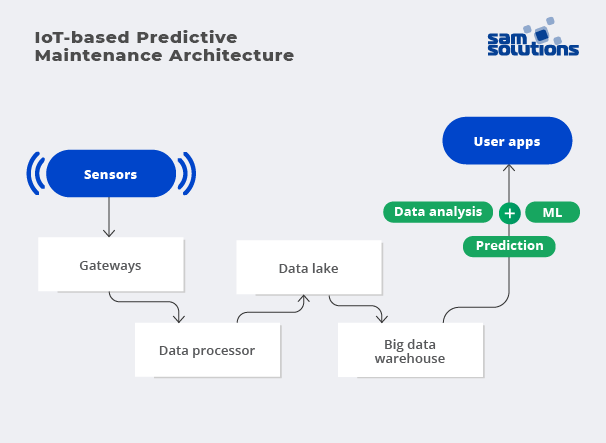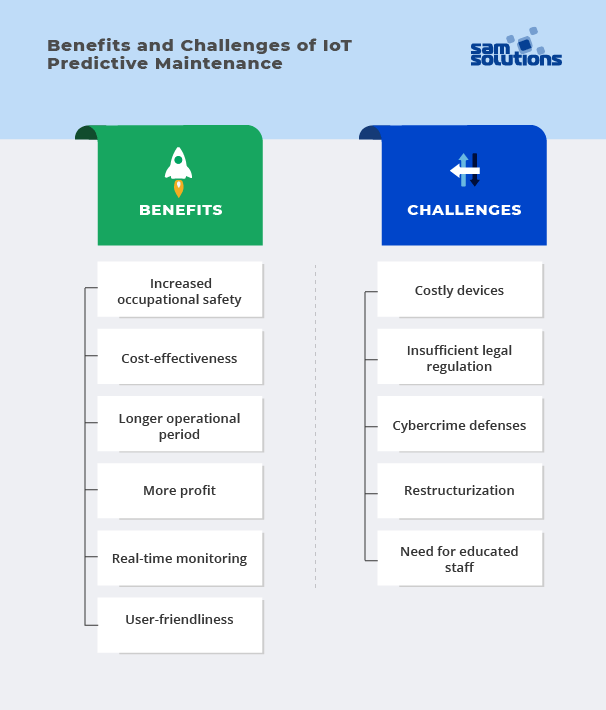Over the past few years, the Internet of Things has transformed the manufacturing field greatly. Enterprises now possess more IoT devices, that help them establish more productive workflows thanks to automated procedures and enhanced communication. The new IoT concept helps companies improve the safety of their equipment, protect data and save money. Read on to learn more about it.
What Is Predictive Maintenance?
Predictive maintenance denotes data-based proactive methods. Focused on IoT solutions and forecasting, it helps reduce the expensive consequences of malfunctions and breakdowns.
What Is the Role of IoT in Predictive Maintenance?
The innovations from this sphere have a noticeable effect on the equipment, its safety and reliability. Consequently, problem-free performance and timely detection of potential failures in machinery allows organizations to allocate resources in an efficient way.
Essentials of the Predictive Maintenance Function
The operation of maintenance systems is based on such latest IT trends as fog computing, big data, AI and ML, deep learning, and cloud computing. IT specialists design IoT platforms adjusted to the needs of the specific projects. They equip systems with necessary devices and ensure stable data flow between them.
When installed, the system can initiate the process by receiving data with the help of sensors. Then it travels to the data lake through the gateway. Afterward, it is structured at a big data warehouse and undergoes comprehensive analysis with ML.
With SaM Solutions’ wide range of IoT services, you get professional support and hands-on assistance at any stage of your IoT project.
Benefits of IoT-based Predictive Maintenance
- Cost-effectiveness. Companies need to renew and swap only the definite parts of the machinery that are known to have malfunctions or abnormal performance. With IIoT technologies, managers can make well-thought-out repair plans according to the unique qualities of the equipment and the sensor data they receive.
- User-friendliness. Customers are satisfied when they can make plan before the equipment breaks. Data analysis allows accurate scheduled inspection of the machinery based on the historical data. The received data is converted into a form that can be easily understood by humans.
- Real-time monitoring. When anything breaks down or is going to break down in accordance with the received data, you will obtain a notification instantly so that you can react timely. The system controls the equipment constantly and checks for any abnormalities.
- Longer operational period. Thanks to regular check-ups and strict requirements, the equipment you have will remain in a good state and will definitely serve you longer.
- Increased occupational safety. Smart predictive maintenance systems are equipped with sensing gadgets that can observe physical properties of the environment such as heat or humidity levels. When analyzing this data, the sensors detect any threats to the health of employees, and the system will receive this signal and instantly send a warning to the users.
- More profit. With predictive maintenance techniques, companies utilize data-driven solutions to earn more money as well. As the equipment breaks down rarely, there is less or no downtime at all, so the actual production process is incessant. Consequently, companies are able to produce more goods and, as a result, enjoy reliability and stable revenue.
IoT-Based Predictive Maintenance Architecture
Sensors collect the data about the environment, such as heat level, lighting, humidity, etc. Then the data is filtered and preprocessed in the gateways. Afterwards, it is placed in the cloud data storage on the processor, which has a goal to provide unceasing data movement and transfer raw data to data lakes.
When companies need data for analysis, they load it in big data warehouses, which stores more refined data. ML algorithms analyze data and identify recurrences. Predictive maintenance models conduct analysis and, as a result of their work, users receive warnings via special apps.

Implementation Stages of IoT-Based Predictive Maintenance
Let’s reveal main stages of predictive maintenance usage in organizations.
- Study equipment. Specify the machinery on which you will enable predictive maintenance devices. Remember that all the equipment you have can not be fit for this use. To figure out what equipment you need, analyze how much it will cost you when every machine malfunctions. Most often, companies utilize maintenance for the most expensive apparatus.
- Identify programming instruments. It is important to buy the right software for your industrial domain.
- Consult specialists. Getting some professional advice is never a wrong move.
The Challenges of Implementing Predictive Maintenance
- Costly devices. To implement cutting-edge predictive maintenance solutions into your daily practice, you often need to allocate serious money to the process. But in any case, these expenditures will result in significant advantages for your business.
- Restructurization. After adding predictive management techniques to your system, you should also align all working processes in your company according to it as well. Devote close attention to the cooperation between maintenance and analytical departments to ensure smooth communication and delivery of services.
- Insufficient legislation. IoT predictive maintenance does not have an abundance of associated legislative acts and laws.
- Trained personnel. To get started with predictive maintenance, it’s not sufficient just to acquire the necessary gear. Trained staff is of equal importance. If your employees do not have the required skills, you can engage third-party specialists that have competency in the field.
- Сybercrime defenses. A lot of time and effort must be put into complying with strict confidentiality guidelines and keeping private data safe in the IoT network and cloud.

Predictive Maintenance by Industry
Discrete Manufacturing
It is not uncommon for equipment to experience downtime as a result of breakage or wear and tear. Nevertheless, advanced predictive maintenance techniques can help. Even when not present at the facility personally, managers can monitor the state of the equipment 24/7 and always get a clear view of what is happening to a particular machine at any given moment in time.
Smart gadgets will collect the necessary data to analyze the current state of the machinery. Consequently, companies can eliminate risks and provide proper care in advance, before anything catastrophic happens. Furthermore, predictive maintenance solutions help make high-quality goods and increase the general efficiency.
Process Manufacturing
The production of goods is a continuous uninterrupted process flow, where all the stages are co-dependent and interconnected. When the flow is interrupted for any reason at any stage, it will inevitably affect other stages as well, and disrupt the entire manufacturing process in the end.
Manufacturers from all industries resort to predictive maintenance techniques to prevent negative results. With IIoT, it is possible to track the state of the machinery, identify performance and deliver service soon.
Oil and Gas
The ultimate objective in this sphere is to lower the amount of money spent on maintenance and mitigate the potential possibility of ecocatastrophe. Enterprises are capable of monitoring the state of their equipment even under the conditions of remote work. It helps lower the expenditures on inspections and provides a sufficient amount of data to forestall downtimes and breakages. Censoring devices facilitate the comprehensive analysis of the state of the equipment, and, as a result of feeding the data into special algorithms, clients can receive warnings about upcoming emergencies.
Leverage the latest IoT technologies with our expert team and get powerful IoT solution for your business.
Electric Power Industry
Electricity is vital for the functioning of home appliances, devices, reliable performance of industrial equipment, Internet connection, and stable communication. It is easier and more cost-effective to detect a problem when it has just begun and hasn’t let to dire consequences yet.
For companies, predictive maintenance can help eliminate or shorten the delays in production due to the necessity of repairs, which saves both time, human resources, and budget. Industrial IoT devices monitor the state of machinery constantly, and ensure that it is clean and functions properly. Gadgets can also ensure that there is no damage done that electric gauges are properly functioning and that everything is in order. Elaborate predictive maintenance architecture will also help increase profits due to enhanced efficiency.
Railways
For safe transportation, railways try predictive techniques as well. Timely upgrade, service and maintenance facilitate proper functioning of the trains, but this doesn’t ensure uninterrupted equipment function in between repair visits. Sensors can observe the state of the equipment constantly and sound an alarm to warn technicians about any alterations in equipment state, so that they can take actions in advance to stave off undesirable delays in transportation and reduce the time spent on repairs. The special signaling system provides instant insights about probable incidents, helps reduce maintenance efforts, and makes weighted data-driven decisions.
Construction
In construction, managers use predictive maintenance techniques to meet the requirements of the modern market. If any significant part of the equipment is broken, the construction team will often be unable to fulfill their tasks and meet deadlines, which can result in monetary losses.
Special real-time control applications allow the project managers to identify any faults in the equipment and possible dangers, based on predictive models and comprehensive data analysis. Thanks to data science and machine learning methods, managers can ensure elaborate maintenance planning and cut expenses on repairs well in advance.
Conclusions
Businesses have implemented old-fashioned strategies to ensure the reliable performance of equipment for years. Obviously, they can not compete with IoT predictive maintenance, which can help solve problems in advance, cut costs and improve productive capacity.



















 The Latest 15 Information Technology Trends in 2024
The Latest 15 Information Technology Trends in 2024 Top 10 Embedded Software Development Tools
Top 10 Embedded Software Development Tools IaaS vs. PaaS vs. SaaS: What’s the Difference?
IaaS vs. PaaS vs. SaaS: What’s the Difference? IoT Development: Top 15 Internet of Things Tools and Platforms in 2024
IoT Development: Top 15 Internet of Things Tools and Platforms in 2024 10 Examples of Predictive Analytics
10 Examples of Predictive Analytics












 Component-Based Architecture in Software Engineering: A Comprehensive Guide
Component-Based Architecture in Software Engineering: A Comprehensive Guide Micro Frontend: What It Is and How It Works
Micro Frontend: What It Is and How It Works SAP Commerce Cloud: Features, Benefits, Architecture
SAP Commerce Cloud: Features, Benefits, Architecture MACH Technology: What Is It?
MACH Technology: What Is It? The 16 Best .NET Development Tools
The 16 Best .NET Development Tools
When you deal with such ground-breaking technologies, you should pay close attention to your level of protection. Cybersecurity is extremely important.
Thanks, very enlightening. I was especially surprised to learn that these techniques can be used to enhance the workflows in the construction area. It was a great revelation to me.
I am all for Internet of Things technologies! They have transformed my entire business dramatically. I incorporated smart gadgets into my management system long ago.
So, uncontrollable malfunctions are a thing of the past? If this means my equipment will not experience downtimes and unforeseen failures anymore, I will give it a shot for sure.
Good to know that it has become possible to predict breakages before they even occur! My manufacturing department has suffered a lot due to unsuspected failures.
Very thought-provoking. I suppose all the expenditures on the equipment are feasible, while implementing such technologies will result in higher ROI and increased profits.
Thank you for the article. Now I’m thinking about trying these technologies for my company. However, I may require professional help in the future to help me with the implementation.